#any borges gif hunt
Text
Blaze's Compendium Entry #3: Do not try to steal from Vouivre!
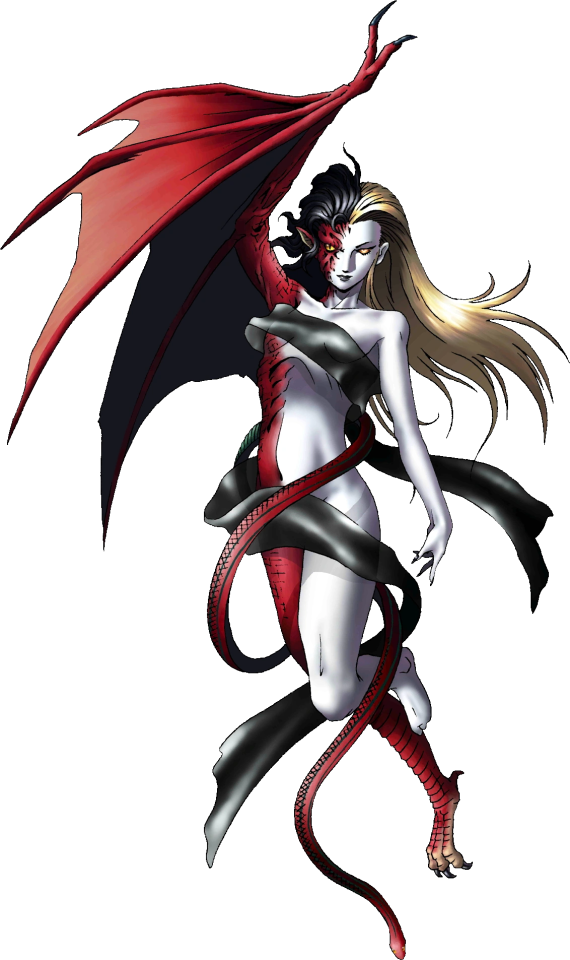
The Vouivre is known to be a Draconic creature from the French folklore. Specifically from the Eastern part of France. The Vouivre is not to be confused with her fellow local dragons such as the Guivre, Wivre or the Melusine. Her differs herself for two key elements: Her almost always feminine humanoid looks (Although, sometimes shes also described as a fierce serpentine dragon) And the jewel in her forehead, called the Carbuncle. This jewel is precious to the Vouivre because it grants her eye sight, and also (according to some sources) heat. It could also be or not be her only eye, depending on the legend.
Vouivres are neutral beings. Generally they don't pick fights with humans, only if provoked or in self defense. Which is fairly common, since the greedy humans try to steal her jewel all the time, which is said to be more valuable than ''any mineral found in any Brazilian mine'' (Jenin Clement, 1884: ''Traditions Populaire de la Cote d'or'')
The jewel received it's name thanks to the Latin world ''Carbunculus'' which meant something like hot coal. That's because, according to the legend, the Vouivre's jewel was hot and bright like hot coal.
It does not help that the Vouivre is usually hoarding lots of gold and treasure in her lairs, which also attracts many unwanted attention. If, the Vouivre needed to fight, fortunately for her she was blessed with such strong flames that she could completely carbonize a human being to ashes. (Faune et Flore de la French Comtee, 1910- Beauquier)
But more often than they would like, the Vouivre would be hunted down during their most vulnerable period: When she had to take off the Carbunkle out of her forehead, and bath or drink water. That's the period she had to protect the Carbuncle, it should not fall into water, it would lose it's fire powers. And although there's few to no sources that state that this would kill the Vouivre, the Faune et Flore de la French Comtee book states at least one instance where removing it for too long would kill the creature. If you consider that the Carbuncle is destroyed after falling into water, it means she would also die.
In most of the tales, the Carbuncle serves as the Vouivre only eye. There's few sources where it is just a jewel embed into the creature's forehead, and in others it was part of a crown she wears. According to some sources as Jenin Clement, 1884: ''Traditions Populaire de la Cote d'or, looking directly to her Carbuncle (or her eyes) would cause confusion, panic and fear, making you completely immobilized.
According to a web page from the Fremch Comtee government, the Carbuncle is ''so valuable that not even all world's gold could afford it.'' This page in question is long dead, but there's some content of it available at the site Blackdrago. Not the most reliable source out there, but at least they saved this page's content. Also saved in Blackdrago, there's also a dead link to an article of the Fremch Comtee government about the origin of the Myth. This page is available at the wayback machine!
Fun fact: Carbuncle is also the name of the infection caused by the Anthrax. Anthrax has its own name meaning ''coal'' (ἄνθραξ) in greek. That´s because the infection causes skin damage that looks like coal. The relation with the Vouivre is probably none, but i thought it was cool enough to put here. Please i can't stress it as much as i want but do not google it!
For those more versed in Mythological beings, demons and mysterious fantastical beings, you may recall the name Carbuncle as another mythical creature from the South American Folklore. The Book of Imaginary Beings, 1975 edition (Jorge Luis Borges) Describes the Carbuncle as a mysterious creature that the 16th century Spanish Conquistadors painted as elusive. A poet-priest called Martin Del Barco claimed to have seen one in Paraguay, and has described it in its 1606 poem ''Argentina'' (If you asked me, it's weird that it was in Paraguay, but was featured in the Poem named Argentina... but, ok.)
The Carbuncle, not only for it's name shared an eerie similarity with the French Vouivre. Martin described it as a ''small animal, with a shining glowing object in it's head, like a glowing coal.'' It's jewel was also sought after, and supposedly very valuable. I wont dive too deep in this creature here and now. The point is that the Vouivre had some similar creatures, even such a distant ''cousin'' as the Carbuncle of South America.

Final Fantasy's interpretation of the (Creture) Carbuncle.
Back to the Vouivre:
The window of time to get the Vouivre in her vulnerable state varies according to the region, or tale. Some say is once a year, or even weekly. The book ''The Drac: French tales of Dragons and Demons'' (Felice Holman, Nanine Valen, Stephen Walker - 1975) Tells about a tale where the Vouivre comes out only once a year. Normally the sources agrees it's when there's an important mass, and the people are too busy to care about the creature. This could be at Easter or Christmass (Christmass would be specially told in the Audrey region). In deeply catholic societies, nobody would flee from the church just to hunt the Vouivre. (Oh boy some did)
In tales from Monthier the Vouivre would come out at the eleventh first midnight bell from the clock, during Christmas night. The common sense is that they are generally very intelligent, that's how they know the perfect timing to be alone.
But also on her weak spot was the fact that the Vouivre had very frequent habits, which could mean that someone smart enough would eventually figure out how to reach her. She also had the ability to stun foes, although i just found one source about this skill in the book Jenin Clement, 1884: ''Traditions Populaire de la Cote d'or' Honestly, she's just trying to be alone, hoarding her treasure and caring for her hygiene. I can relate.
According to the book ''Faune et Flore Populaires de la French Comtee'' The name Vouivre came from the Latin word Vipera, which means viper. Vouivre can also means just ''wyvern'' in a general term, and not specifically this tale. Going by the Indo-European root you get to the word ''Gwer'' which means something warm or hot. From there, the word Wyvern comes from. It was meant to refer a fire serpent, or a type of dragon. This relation with the warmth and heat could also explain the Jewel that the Vouivre has, and the relation of this creature with the fire element.
There's some speculation about her name influencing regional dialects. For instance, the Morvan Dialect Glossary has the word Vouavre. This could mean heat or something wet. If the translation goes for the first option, this could theoretically be another association, or even where the original name of this dragon came from. Morvan is a dialect of the region Burgundy and is a french derivative. But i could not find any translator for this dialect, nor any confirmation this word even exists, so take it with a grain of salt.

She could canonically use agi!
There's a lot of places in Eastern France that bears the Vouivre name, that's how popular the legend was there. Many of those places are described in books such as the ones mentioned above (sources will be in the end of the article) are simply too old, some are not even there anymore. But surprisingly you can use google maps to check, and see that still there are many places with the name out there.
During my research, i also found out there's a french movie about this legend, called La Vouivre (1989). Honestly, it seems pretty interesting. It's about a WW1 veteran who became obsessed with the legend. (Just as did i, when i wrote 40ish pages of research for this text) I will take my time to watch it some day, and i will probably post my thoughts here.
Because their tendency to get mugged by Humans, Vouivres tend to like isolated places, where they can live alone and in peace. This could be old monasteries, old castles, caverns, or deep woods. No matter the source, Vouivres always like to be alone, have regular habits and are (mostly) neutral. Some of those locations in Eastern France are so associated with this creature, that it has either named it or became a symbol of this place.
Take for instance The castle of Vaugrenans. (We will be back to it later) The place was destroyed in the 17th century, and now is just ruins in which people said a Vouivre lived. It got so associated with it, there's a sign near it telling about the legend. In this case, the Vouivre was also interpreted as a creature who controlled, and used snakes. This particular feature can be seen in Kaneko's design of the Vouivre, since she has a snake in her body.

This Picture was taken from Google Maps, you can check by yourself! It depicts the Vouivre from the Vaugrenans Castle ruins.
The Vouivre were also commonly associated with rivers and streams, where supposedly they took their baths and drank water. Some hills, falls and mounds also got associated with it.
At least in one Source they used their feminine looks to seduce the human assailant, and get out of the danger. (Jenin Clement, 1884: ''Traditions Populaire de la Cote d'or').
Most of sources agrees that the Vouivre has bat-like wings, and when flying through the night sky, lets out a flame trail, like a shooting star. The sources like the Faune et Flore de la French Comtee, 1910 states that the creature could reach 2 meters tall.
The book ''The Drac'' Describes some tales of people that tried to actually rob the Vouivre. One man actually succeeded in getting her treasure, but not the Carbuncle. He made home with gold, but ended up dying by a mysterious illness, and the fortune disappeared.
In the Faune et Flore de la French Comtee, 1910 book, there's a legend about a man that succeeded in stealing the Carbuncle and also killing the Vouivre. The man blinded the creature taking the jewel, and had prepared beforehand a pit full of spikes. The man made the dragon fall to her death, and took the Carbuncle. But the thing was so valuable he never managed to sell it, dying without seeing a single coin from it. The treasure vanished not long after his passing.
Another tale from this particular book tells the horrifying story of a poor and hungry family, that ended up trying to steal the Vouivre's treasures to survive. The mother has the not so great idea to invade the dragon's cave with her infant son, while the creature was absent. But they takes too long that the Vouivre gets back before they could leave. In a hurry the mother left the children behind, who got stuck inside the cave when the Vouivre closed it. The mother waited camped in front of the cavern getting help from her neighbors, crying for her son. Exactly one year later, when the Vouivre exited the cave, her children was unharmed and could escape. Honestly, who would invade a dragon's den with a toddler? That's on her.
The legend was also spread from all over Eastern France. Regions such as Burgundy, Niverneeis and Baurbonnais were also prolific Vouivre nests, according to legend.
In the book Faune et Flore de la French Comtee, 1910, the author also compares the Vouivre to two other mythical beings. First: The Basilisk. Some people made this association due to their similar habitats, but the Basilisk being actively violent towards people.
There's a piece direct from page 12:
''...It (The Basilisk) was believed to be close related to the Vouivre. But much more terrible. (...) It inhabited old walls, attics and old houses, and guarded treasures...''
There are some similarities, but those are generic traits of mythological monsters and demons. They could be attributed to any creature, but i found interesting.
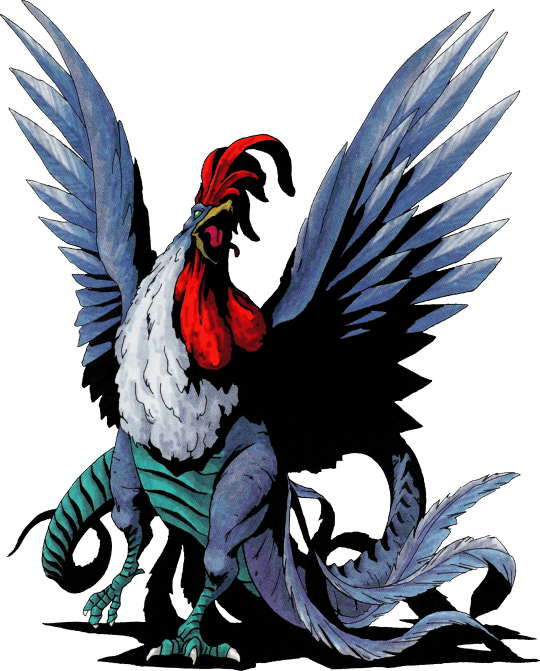
The Basilisk, by Kazuma Kaneko.
The other mythological creature discussed in the book that could be related to the Vouivre is the Melusine. Another distant cousin? The Melusine are humanoid creatures, sometimes half fish and half snake. In this book, the author draws parallels to the Vouivre, due to Melusine some times possessing snake-like features.
Much popular in Europe during the 14th century, the myth of the Melusine ended up making appearances in many coat of arms around Europe. Like the Holy Roman Germanic Empire, Escandinavian and the Warsaw City. Although many times treated as a snake, the association with the Vouivre comes from some draconic interpretations. This could be one of the origins, but its unclear.
This was not the only mention of the Melusine relation with the Vouivre. In the book Jenin Clement, 1884: ''Traditions Populaire de la Cote d'or', this also mentioned. They do share similar bodies, but the Melusine lacks the distinct Jewel in her forehead.
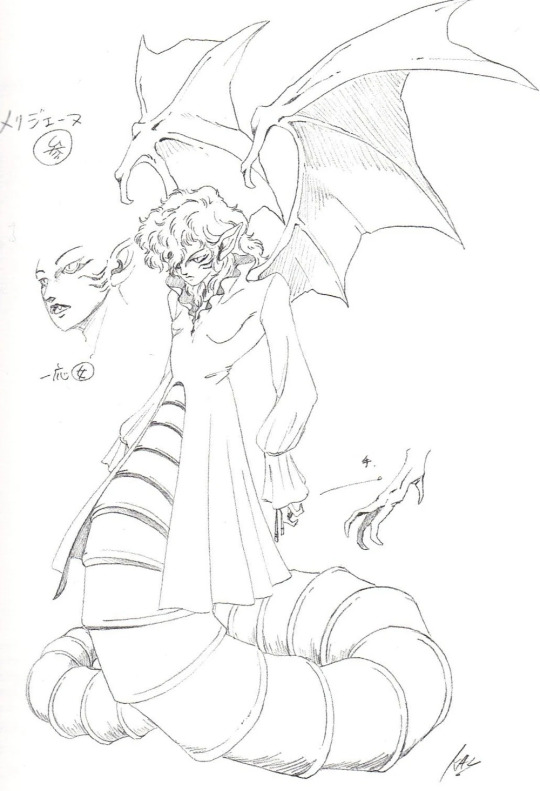
The Melusine, as it is portrayed in Shin Megami Tensei: If... by kazuma Kaneko.
There are some surviving records of first hand accounts of people who swear that they saw the creature. According to Faune et Flore de la French Comtee, 1910:
-In 1835 a villager from Jura, in the Dole district was about to go inside a pit where he saw treasure. He supposedly ran away crying in horror and blacked out. He said he had met a Vouivre face to face. Other villagers from that place and time swear they saw the creature as well.
-In 1850 in Augeraus someone actually tried to shoot the thing. According to the account, the demon was naturally unharmed.
Again at the book Jenin Clement, 1884: ''Traditions Populaire de la Cote d'or', There's actual names of People that got involved with the creature, supposedly:
-A couple called Jaquot and Jaquette (There's no way this is real, this is some serious Wario and Waluigi stuff)
-A Man called Nicolas Broreau
According to legend, this man actually survived his encounter while trying to steal from the creature. The creature stunned and seduced him, using her brains to get her jewel back. She even gives him some of her gold, but since he did not made what she demanded, the gold turned into rocks. This was also one of the few instances of sources where the Vouivre had two eyes, and not only the Carbuncle.
Those were the more interesting ones, but there are a lot of cases, and a lot of legends, it's hard to put everything down here. But again, sources will be in the end.
But by far the most interesting story of the Vouivre came from the book Jenin Clement, 1884: ''Traditions Populaire de la Cote d'or'. Here we go back to the castle of Vaugrenans, a chateau in eastern France. We are presented to the owner of the castle, but she was ruined by her beauty and excesses. This turned her into the demon Vouivre, who terrorized the town. She had a son, a knight who fought her to put an end to her destruction. According to this legend, the archangel Michael helped the Knight named George, who ended up killing the Vouivre destroying her Jewel and crushing her with his Horse.
In depression for killing his mother, he asks the Archangel to be punished. Michael burns the man and spread his ashes. He later is reborn as a child again, and was supposedly canonized.
When i first read this story it caught my eye that this is too similar to the Saint George tale, of killing a dragon. The name and everything. This tale could be indeed be a rationalization of the saint's lore. As i said above, this place is indeed known for the Vouivre legend, but there's nothing there indicating that this Saint tale is really associated with it as far as i have gone.
There's also a city in north-western France, called St. Georges du Vievre. This city has a name very closely related to the Vouivre and also depict a Saint George. This village today has less than 1000 people living there, and was first shown in a map in 1164 with his latin name: ''Sanctus Georgus De Wevra''.
Supposedly, Vievra refers to neraby woods called Guevra. This was the name of the place at least at the 11th Century. The name indicates that there was a dragon who ate children living in that place, that according to legend was killed by Saint George. (Probably not the same of his legend, this could be a regionalization of the myth, but all indicates it was just a regular Wyvern) This dragon was a Wyvern, the original meaning of the name Vouivre. Simply a Wyvern. The word could predate Latin, maybe going for more indo-European roots, but honestly it's hard to know.
The emblem of the village is literally Saint George killing a giant snake, which take us back to the original meaning of Vouivre and Wyvern, coming from the Latin word Vipera.

This village, as far as my research has gone, lacks any Vouivre tales or legends. Instead, the name here is merely a recall to its original meaning as the word for viper and Wyvern. This was sourced by the book ''Gentillhomeires des pays de l´eure'' Franck Beaumont, 1999. I've only found articles about it, the book is quite elusive. If you have it, or ever found it let me know!
In conclusion:
As such any local folklore, it's almost impossible to pin down the origins for the myth of the Vouivre. The common theme here is that of ''Risk and Reward'' type of cautionary tale, but also the European fascination with dragons.
Dragon tales were not uncommon at France, and we even already told about the Wivre, Guivre and many others. What makes the Vouivre tales interesting is that she was almost always minding her buisness, when the humans are the ones who cause her trouble. It's also worthy to note how in almost all of the tales there's never a happy ending for those trying to steal from the demon, even when they seems to achieve success in their endeavors to get the treasures from the Vouivre, something goes wrong. It goes to show how some things are just not made for human hands, no matter how much our species try to go over it. There was never pressure to hunt the Vouivre, most of them were not doing anything wrong in their tales, but yet the Humans tried to conquer their power to themselves.
There are many other interesting draconian mythological beings in Europe, and the Vouivre is specially popular in the particular Eastern region of France. It's a good display on how folklore and cultural traditions can influence a community, becoming naming conventions and symbols of that place's history. Today there's many people that fight to preserve this history, and i believed that researching and posting about it would do it's part.
I hope you all enjoyed. Please reblog, like, or interact to the post to spread the Vouivre's tale.
And remember, never try to steal from the Vouivre!
Sources:
Jenin Clement, 1884: ''Traditions Populaire de la Cote d'or''
Faune et Flore de la French Comtee, 1910- Beauquier
The Drac: French tales of Dragons and Demons'' (Felice Holman, Nanine Valen, Stephen Walker - 1975)
About the South American Carbuncle:
The Book of Imaginary Beings, 1975 edition (Jorge Luis Borges)
Note: All the books are in french, and i used software translation to read it. I am not familiar with the French geography, so if i got any place or name wrong, let me know!
#Vouivre#shin megami tensei#devil summoner#mythology#european mythology#french folklore#kazuma kaneko#wyvern#mythology and folklore#folklore#dragons#atlus#Vaugrenans#blazescompendiumentry
49 notes
·
View notes
Text
SO I don't post a lot (in general) of media analysis and speculation but I do love The Owl House and Star Trek. Cosmic Frontier, the book series that Gus and Hunter base their Halloween costumes from is very much a HUGE Star Trek reference (+ other space operas).
I think Gus is using the story to convey to Hunter that he knows he is a Grimwalker but that's not what I wanna talk about here.
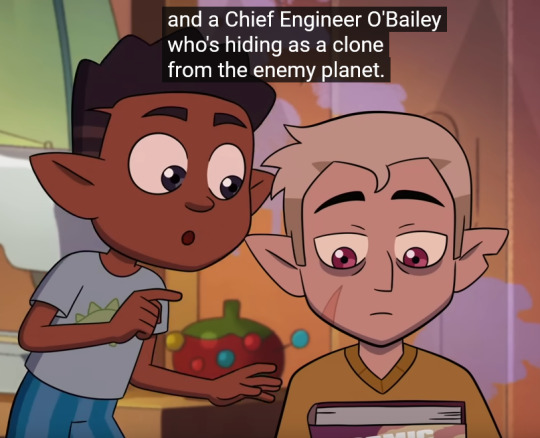
Chief Engineer O'Bailey is DEFINITELY a direct reference (name and some costume details) to Chief Engineer Miles O'Brien. It should be worth noting that:
O'Brien wears a similar gold uniform to both the in-universe character, and the colour yellow/gold is very associated with Hunter.
The yellow uniform was actually initially a leadership uniform in the Original Series but was changed in the sequel series, TNG, to engineering and security roles. Might be a reach here but it does reminds me how Hunter went from a leadership/commanding role to one where his concerns are protecting his new friends and family (security) and enjoying creating and fixing things (Which is pretty much what engineering role characters Star Trek are constantly doing).
The writers on the Star Trek spin-off DS9 (which O'Brien moves to from TNG) LOVE to make O'Brien suffer. Like every season has O'Brien suffering. It's an in-joke for the writers. Remind you of anyone?
MILES O'BRIEN'S WIFE IS A BOTANIST. PLANTS!
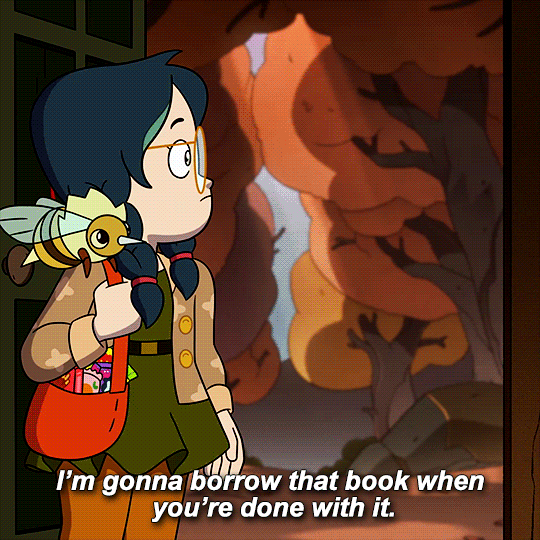
I'm pretty certain someone has already made the Borg connection with the character/costume too. The eye visor is very reminiscent of Hugh in particular. Basically the Borg are reoccurring antagonists that as a collective assimilate any humanoid species they come into contact with. Assimilation is basically being controlled by a giant hive-mind (direct parallel to the Coven system and what not) and strips away any individuality, culture or freedoms.

Hugh (pictured above, although at this point in the narrative, not named that), a Borg, is found injured but unconscious from a scout ship crash (kinda like in Hunting Palismen) by the Enterprise crew. The Borg are very much an established dangerous antagonist in this point of the series.
Initially they consider leaving him to die because the Borg are the Big Bad but the ship's doctor insists he gets medical attention. Hugh is just a kid (iirc he's like ~15-17, a similar age to Hunter). Over the course of his introduction episode Hugh, learns that humanity doesn't want to be assimilated. Assimilation would effectively kill his new found friends (La Forge in particular).
There's some very obvious narrative beats that match what happens in both Hunting Palismen and Any Sport In A Storm. There's also the loneliness that Hugh feels and expresses not knowing his purpose or being connected to the rest of the Borg. When Hugh is reunited with other Borg at the end of the episode, he expresses that he doesn't want to lose his newfound individuality and friends.
Anyway I really like the narrative connections here! Good stuff!
#the owl house#toh spoilers#hunting palismen#any sport in a storm#thanks to them#toh#long post#huntlow
81 notes
·
View notes
Note
::Nice to know my favorite borg still thinks of me after all these years.::
The ace of a familiar grey hare appeared on a nearby computer as Mal texted Adam.
::Also, you’re right. The Net here is nothing more than garbage.::

Smasher’s glowing red cybernetics looked at the screen, it was hard to read what kind of emotion he was feeling… IF he was feeling any at all.
::Leave. I will not be afraid to hunt you down like the prey you are if you choose to antagonize me.::
1 note
·
View note
Text
By clicking here, you’ll find 150 gif icons of the brazilian digital influencer Any Borges. All these gifs were created by me ;; so don’t steal them, claim them as your own or include them in other hunt. I will be grateful if you like it or if you think it is useful!!
Clicando aqui, você encontrará 150 gif icons da digital influencer brasileira Any Borges. Todos esses gifs foram criados por mim;; portanto, não os roube, os reivindique como seus ou inclua em outras hunt. Ficarei grata se você gostar ou reblogar se você achou útil !!

#rp br#fc help#rph br#blonde fc#female fc#brazilian fc#any borges#any borges gif icons#any borges gif hunt#any borges fc#any borges edits#de ferias com o ex#de ferias com o ex celebs#mgifs.
6 notes
·
View notes
Text
Ok so we all remeber the scene at the end of Hunted where Lloyd faces Garmadon on the roof of Borg Tower("I cannot fight you, but I can resist you"). In that scene, we see that he learns in order to beat Garmadon, he cannot fight him so that he doesn't gain more power.
Which SURE sounds like a lesson he's been taught before.

In Rebooted, Sensei Garmadon teaches the ninja the art of the silent fist, a fighting style that involves letting your opponent fight themselves, while you simply dodge their attacks and prevent them from doing any damage at all.
Lloyd remebers this lesson for a long time, but only now does he realize why it is important, which brings me to my final conclusion.
SENSEI GARMADON MADE SURE TO TEACH HIS SON THE ONLY WAY TO DEFEAT HIM IN HIS EVIL FORM IN CASE HE EVER HAD TO SEE HIM THAT WAY AGAIN
#lego ninjago#ninjago#lloyd garmadon#ninjago lloyd#sensei garmadon#lord garmadon#ninjago garmadon#lego ninjago masters of spinjitzu#ninjago masters of spinjitzu#masters of spinjitzu#just a little angst for yall :)#credit to my sister who doesnt have tumblr for thinking of this galaxy brained headcannon
415 notes
·
View notes